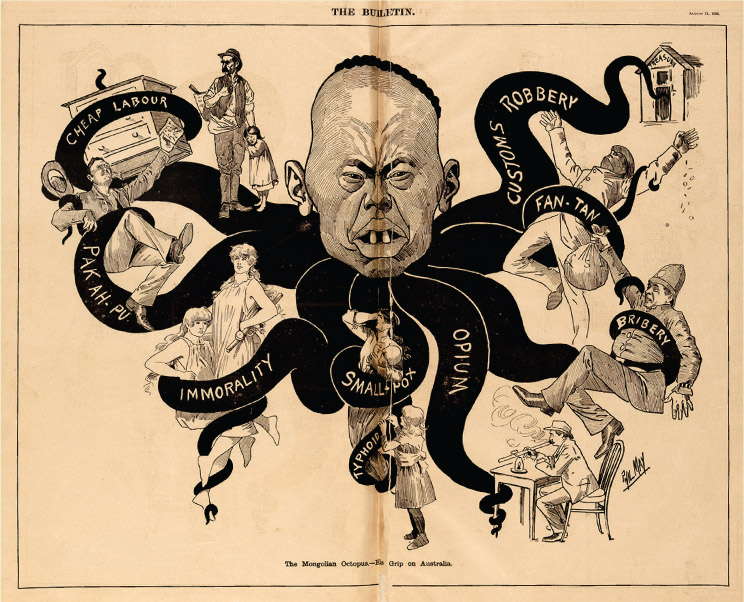Chapter summary
- Convicts, officials and soldiers established the first European settlement at Sydney in 1788. From the 1830s, free settlers flowed into and across Australia, creating a new society.
- The wool industry, the gold rushes and other mining pursuits made Australia an attractive place for investment and led to substantial profits for investors.
- The settlers believed that they could rightfully take the land and the notion of res nullius denied Indigenous ownership and use. This invasion had devastating impacts upon Aboriginal and Torres Strait Islander people, destroying their security, livelihoods, beliefs, languages and physical and cultural lives.
- Non-European migrants from China, Japan, Afghanistan, the Pacific Islands and other places made valuable contributions to the economic and social life of nineteenth-century Australia, but increasingly European settlers asserted that Australia should belong to whites only and attacked these people by physical and legislative means.
- White Australians developed a highly democratic form of government where manhood suffrage, payment of members of parliament and, increasingly, the enfranchisement of women were introduced. However, Indigenous people and non-European migrants were largely denied the opportunity to participate in this political system.
- Australian working and living conditions were difficult and challenging for many at the time of Federation. There was evidence of much social and economic inequality. The new Commonwealth governments began to address some of these problems by introducing the concept of a male basic wage, industrial arbitration, pensions and a female maternity bonus. Aboriginal and Torres Strait Islander people and non-white migrants, however, were once more denied access to these reforms.
Interactive activities
Key terms
Significant individuals
Timeline
Short-answer questions
- Reflect on why there was no recognition of Aboriginal and Torres Strait Islander land rights in the Australian colonies.
- Why did South Sea Islander people return to Australia for a second or third time?
- In what ways was Australian democracy more advanced than that in Britain and the United States?
- Explain why women wanted the right to vote.
- Describe the White Australia Policy.
Source analysis
- In the cartoon below, what is the octopus doing to the different Australian people?
- Research the meaning of ‘Fan-Tan’ and ‘Pak Ah-Pu’.
- Explain why there is a chest of drawers in the top left-hand corner.
- How is the Chinese man presented in this cartoon?
- Compare his face with that of Quong Tart (see Source 14.12).
- Compare this cartoon with the one at the end of Chapter 12 (see Source 12.23) depicting the Chinese man barred from entering the United States.
- Given that European Australians had taken over all the country and land of Indigenous Australians by 1886, could you draw an octopus figure with eight arms presenting an Indigenous view of European Australians as gripping the Australian landmass? With each arm, illustrate one of the damages the Europeans caused to Indigenous Australians.
Extended-response question
Which groups were the main winners and losers in the making of the Australian nation between 1788 and 1914? Try to assess what each group won or lost in the process, and determine the level of their successes, failures, privileges or difficulties.
